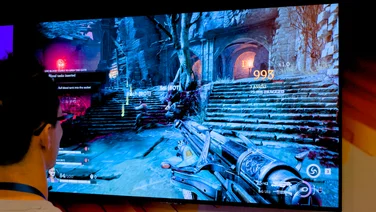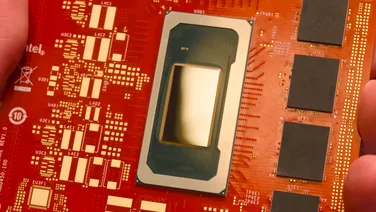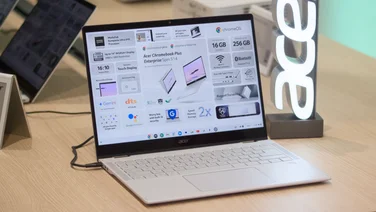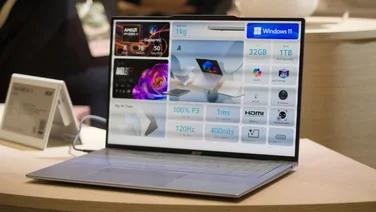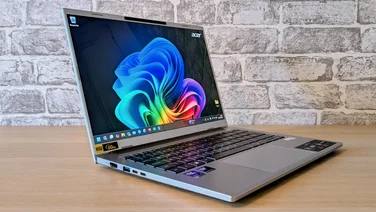To help us provide you with free impartial advice, we may earn a commission if you buy through links on our site. Learn more








We’ve been waiting years for a new Google Pixelbook, but after the latest announcement from the search giant, the wait looks certain to go on. But could we finally have a worthy alternative? The new Lenovo Chromebook 14 Plus, unveiled as the latest poster child for Google’s browser-based OS, is probably the closest we’re going to get.
It was announced at a Chromebook showcase event on Monday 23 June 2025, and it certainly looks the part. It’s powered by the new, super-efficient MediaTek Kompanio Ultra 910 processor (the first ARM chip to feature in any Chromebook Plus device) and Google says it’s the “most advanced Chromebook Plus we’ve ever put out”.
Lenovo Chromebook Plus 14 specifications
| Display | 14in, 1,920 x 1,200, 16:10 OLED display 400 nits (optional touchscreen) |
| Processor | 8-core MediaTek Kompanio Ultra 910 processor, 11-core GPU, 50 TOPS NPU |
| Memory | 12GB or 16GB of LPDDR5 RAM |
| Storage | 128GB or 256GB |
| Camera | 5MP webcam with physical shutter and dual microphones |
| Biometrics | Fingerprint reader |
| Wireless | Wi-Fi 7, Bluetooth 5.4 |
| Audio | 4x 2W Dolby Atmos speakers |
| Battery and charging | 60Wh battery with 65W charging and up to 17 hours battery life |
| Dimensions | 314 x 219 x 15.8mm (WDH) |
| Weight | 1.17kg |
| Price | From £599 (non-touchscreen) |
Design, features and first impressions
Doubtless there will be plenty of disappointed Pixelbook Go fans (myself included) at yet another year without an official replacement. But the Lenovo looks like a prime candidate to replace it.
It’s smart and feels well made, measures a mere 15.8mm thick and weighs 1.17kg – that’s less than a MacBook Air 13in. It’s available in either “seashell” or “lunar grey” and its minimalist design looks clean and sharp; I especially liked the rubberised ribs covering the entire underside, in a not-so-subtle nod to the design of the original Go.








Flip the lid and the good news keeps piling up. The display is a 16:10 2K OLED unit (1,920 x 1,200), so picture quality should be top notch, there’s a fingerprint scanner for quick unlocking and – as per the original Chromebook Plus specification – you’re getting a 5MP (1080p) webcam so video calling should be nice and sharp.
Chromebook Plus devices were devised by Google in 2023 to help consumers identify ChromeOS laptops that are capable of a little more than the ultra-cheap, sluggish and badly built machines that litter the digital shelves at Amazon.
To guarantee a certain level of performance, a Chromebook Plus device needs to meet a certain minimum specification. Until now, that has been as follows, but will presumably be updated to encompass the new MediaTek Kompanio Ultra chip in this latest Lenovo:
- – Intel Core i3 12th gen CPU or AMD Ryzen 3
- – 5000
- – 8GB RAM
- – 128GB storage
- – 1080p webcam with noise reduction
- – Full HD IPS display
Chromebook Plus devices have also, in the past, had access to exclusive software features such as additional controls for video and audio quality, Help me write and Help me read in Google Docs and the Magic Editor for removing photo bombers from your holiday snaps.
All the really exciting stuff, however, is happening on the inside of these new Chromebook. This is where we get our first look at the latest laptop silicon from Mediatek: the Komanio Ultra 910. Unveiled in April 2025, this is the first official outing for the company’s flagship chip, and it looks very impressive indeed.








It’s an 8-core chip running at up to 3.62GHz, it has an 11-core GPU with support for Ray Tracing and – perhaps even more significantly – its NPU (neural processing unit) is rated at 50 TOPS (trillion operations per second), two more than the Qualcomm Snapdragon X series. It’s backed up here by either 12GB or 16GB of RAM, depending on the version you opt for.
Some quick internet sleuthing (search for code name Rauru on the Geekbench 6 browser website) reveals that this chip has already been benchmarked quite a bit, and we’re looking at Geekbench 6 scores of around 2,400 for single core operation and around 7,500 for multi-core (MediaTek’s official launch figures put those scores at 2,600 and 8,000 respectively).
For single core stuff, that puts the Kompanio Ultra, and thus the Lenovo Chromebook Plus 14, right up there with flagship Qualcomm X series laptops such as the Microsoft Surface laptops and the Asus Zenbook A14, although it does fall short on multicore.
Not only are you getting zippy performance, though, the Kompanio Ultra looks to be pretty efficient, and should help Lenovo Chromebook Plus 14 to some pretty epic battery life. Google is reporting up to 17 hours in mixed use based on its tests. Again, that’s up there with the best laptops we’ve tested.
Couple that with fanless operation, Dolby Atmos speakers, Wi-Fi 7 support and up to 256GB of storage, and this new Lenovo looks the full package.








New AI exclusives
But of course, it doesn’t end there, because Google is also endowing the new machine with a couple of exclusive AI-based features, alongside a handful of other new features that are coming to all Chromebook Plus devices.
The exclusives are Smart Grouping – where ChromeOS organises your many browser tabs into themed groups automatically – and a small selection of AI image editing tools added to the photo library, including object removal, background expansion and sticker-making capabities.

They’re exclusive because they take advantage of the AI capabilities of the MediaTek Kompanio Ultra processor to run entirely on-device. Forgive me for not getting too excited, though; these are things we’ve seen on smartphones before.
The rest of the new features will be available across Chromebook Plus devices. I’ve detailed those below:
- Select to search, is the headliner and and if it sounds familiar, there’s a good reason. Yep, this is the laptop version of the popular circle to search feature on phones, except instead of drawing a circle, you … um … draw a box with your mouse on screen then quickly search the internet based on what you selected.
- Text capture is a sub-feature of Select to search and delivers you a number of contextual options you can act on once you’ve selected a something on screen containing text. Google demonstrated this by capturing an entirely image-based invitation – the tool understood it was an invitation and gave the user the option to add it to your Google Calendar
- Generative AI images on demand – Using the Quick Key (a relatively new addition to Chromebooks that replaces the Caps Lock key on new devices) users can now insert an AI-generated image on the fly, straight into documents without having to use a separate app
- Simplify complex text – The Help me read features introduced in the last Chromebook Plus update now has a new tool, aimed at making complex, technical text easier to digest. Just hit the Simplify button and, in theory, it should turn long-winded, overly wordy prose into something you can read quickly and without getting a headache – should have no problem with John Milton, then

Lenovo Chromebook Plus 14 hands-on: Early verdict
It’s a shame Google STILL hasn’t released a Pixelbook Go 2, but this looks to be a fine alternative. It seems to be well made, comes with an OLED display and a fast new ARM chip that should deliver long battery life.
And the price looks to be pretty competitive as well, with a starting price of £599 for the non-touchscreen version. Nothing will quite capture the imagination like a new Pixelbook, but let’s hope that this one delivers on its promise.
We’ll be getting our hands on one of these laptops very shortly, so watch this space for the full review.


